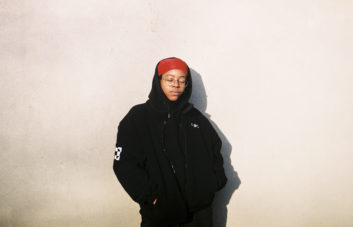Item 1 on the agenda: I shall henceforth spell Disco with a capital ‘D’, as it is a proper noun. And if primary school taught me anything, it’s that girls can be cruel and heartless. And also that proper nouns start with capital letters. Also don’t eat worms. Or bits of wood. And don’t punch bee hives. Or teachers.
Item 2: I’d like to point out that the title for this piece is a reference to the band, Faze Action, who have a song called Disco Warrior. Faze Action are a 6-piece British band headed by brothers Simon and Robin Lee, and are one of the very few bands I can comfortably refer to as being of the ‘Nu-Disco’ genre. The cosmic theme and sound of their recent LP, Stratus Energy is reminiscent of the synth-heavy ‘Space Disco’/’Cosmo-Rock’ of the late 70s; bands such as Space (pure French genius), Cerrone (whose single ‘Supernature‘ may sound familiar to fans of Belgian pop duo Aeroplane) or the excellently costumed Austrians, Ganymed. The album also offers qualities not so commonly featured in the long-gone sub-genre such as horns and soaring vocal harmonies. On top of these welcome editions, the band is a lot more main-stream than its predecessors and exquisitely produced in a modern studio-setting, making the music 100% club-friendly – just wait till you have a crowd full of people chanting along to the Stratus Energy anthem, Good Lovin’, and you’ll know what I mean!
Item 3: The O’Jays. These guys formed back in 1958, in Canton, Ohio (more specifically, at the Canton McKinley High School – cheers last.fm, for knowing things so detailed, they’re not quite worth knowing), as an all African-American, Soul/Motown vocal group consisting of Walter Williams, Bill Isles, Bobby Massey, William Powell and Eddie Levert. Back then, though, they weren’t known as ‘The O’Jays, but instead originally sported the monikers of ‘The Triumphs’, followed shortly by ‘The Mascots’. They apparently achieved some commercial success as early as 1961, with either a song titled ‘Miracles’, or under the alias of ‘Miracles’ – I can’t find any reliable source of information regarding, though this success was supposedly limited only to the band’s local townships and the nearby Ohio, city of Cleveland. Despite this minor success, original members Isles and Massey left the band. The now trio of Williams, Powell and Levert took on the name ‘The O’Jays’ in 1963 – a tribute to radio DJ, Eddie O’Jay, who frequently aired their material and offered them career advice. They then, that year, achieved much more recognizable success with the recording of the song ‘Lonely Drifter’, a fairly typical yet entirely respectable Motown tune which charted nationally.
While this may all seem a bit irrelevant to the realms of Disco music, I think it’s really interesting and pretty damn impressive to see a band which in future achieved so much success have such humble beginnings and an admirably original, creative and unique musical career that left a big ol’ foot print on the road to what would become, Disco music. Despite the more remarkable success of ‘Lonely Drifter’, the boys were thinking of retiring from the biz, before Gamble & Huff (Kenneth Gamble & Leon A. Huff), a team of producers and songwriters working out of the city of Philadelphia, in the neighboring state of Pennsylvania, with a great track record of productions, picked up the group and began work with the band on their CBS-backed label, Philadelphia International Records. From then on, Gamble & Huff played such a huge role in the success and endeavors of the band that from here on out, whenever I mention ‘The O’Jays’, or, ‘the band’, I’m referring to both the vocal trio, shooting out electric streams of sonic dreams (‘singing’, I think it’s more commonly referred to) and the musical force of Gamble & Huff. Gamble & Huff now hold legendary status – having written songs and produced records for The O’Jays, MFSB, Harold Melvin & the Blue Notes, Dusty Springfield, Wilson Pickett, Lou Rawls, Teddy Pendergrass, Billy Pall, Aretha Franklin, a hell of a lot of others, and none other than (except for all those previously mentioned and the ones that I didn’t mention but whom were/are also subject to the criteria necessary to be featured in this now rather incomprehensible list…) the Jacksons, they have racked-up over 170 gold and platinum records. That’s not a typo. One hundred and seventy. Holy shit.
In 1972, The O’Jays (including you know who!), following a long year of studio work released their debut full-length LP, ‘Backstabbers’. The entire album, most notably the title track, reaching 3rd position on the US Billboard Hot 100 and #14 on the UK Singles Chart, pioneered the ‘Philadelphia Soul’ sound – also known as ‘the Philadelphia Sound’, ‘Philly Soul’, or ‘Sweet Philly’ – which became a pop phenomenon, leading to the group’s break into mainstream music culture and achieving record sales in excess of a million copies. The band even had the honor of performing on the TV’s famous Soul Train. While, yeh, the defining of an entire musical movement is notable, and of course extremely impressive, that’s not why I – or ‘we’ – are interested in this record. The final track of the LP – number 10, that’s side B, track 5 – was something a little more… relevant. An entirely original piece of music not only in terms of musical arrangement or structure but also with a new mood, new meaning, a whole new feel about it that hadn’t really been heard before. The track was ‘Love Train’, an up-beat, up-tempo piece featuring a relentless 4-to-the-floor beat accompanied by extensive orchestral string movements, a backing horn section, a heavy emphasis on the chorus and the lyrical expression of togetherness and, literally, global unity.
An absolute work of genius on behalf of Gamble & Huff paired with a passionate performance from the trio – a new style of music attempting to exceed all barriers. Rather than trying to focus on only the unity of the Black community, or restraining the music to the use of the more conventional or traditional Funk and Soul ensemble of drums, bass and electric guitars, the occasional horn section or organ, this anthem appealed to all, and combined the soul and pep of Funk with the energy and excitement, the sweeping strings and powerful horns, of a full orchestra. I want you to understand that this song was not written in the mindset of – ‘Hey, let’s cash in on this pop-phenomenon! Let’s write a ‘Disco’ song like everyone else is doing.’ Disco didn’t exist! The pop charts were still dominated by the Folk, Funk, Rock and R&B of the 60s. The O’Jays literally, unwittingly, defined what Disco as a genre would come to be known. The entire musical arrangement and lyrical emphasis would be emulated, copied, repackaged and sold in the masses year after year later, achieving gargantuan commercial success and selling millions upon millions of records, by almost every artist to hit the charts with a Disco track between 1974 and 1985. This monumental tune was recognized by radio stations, DJs and music fans all around the world, and gained the commercial attention it deserved the following year, 1973, shadowing the success of the record’s title track, ‘Backstabbers’, it reached #1 in the US on both the Billboard and R&B charts, and #9 on the UK Singles Chart. The trio was again featured on Soul Train. Soul Train also featured the track in one of their even more famous Line Dance segments. That’s kind of a big deal.
In my opinion – Love Train was the band’s pinnacle of success. They peaked upon the release of their debut album. While they continued to release good material throughout the 70s, hitting the US pop charts five times more, and four times the UK, and with seven further charting LPs in the States, I feel that they never were able to top Love Train. But hey, it’s not something I’m bothered about. Usually if a band you are fond of peaks early and is never able to re-live its glory days, you are a bit upset, right? Well not for me and The O’Jays – I’m glad they peaked early. Not because I’m glad that they never again reached that level of success, or because I lost interest in them having reached that level of commercial success, but because I am so thankful that they created this revolutionary sound. A sound that established, or kick-started, at any rate, an amazing genre, style and feel of music that would go on to define an entire decade and provide that decade’s people and all of the people to come, with some of the most amazing, emotional, blissful, entertaining, enjoyable, inspirational and limitlessly moving music ever created. ?
ROOTS:
Direct link: The O’Jays – Lonely Drifter [256kbps AAC] The O’Jays first single, a typical Motown piece from 1963. Before the addition of the legendary Gamble & Huff.
HIDDEN GEMS:
Direct link: The O’Jays – When the World’s at Peace [256kbps AAC] Heavy, heavy Funk jam from the debut album, ‘Backstabbers’.
HITS:
Direct link: The O’Jays – Backstabbers [256kbps AAC] US #3, UK #14 – 1972. Quintessential Philadelphia Soul. This song launched the band into the mainstream music scene and paved the way for the success of the follow-up single and Disco pioneer, Love Train.
Direct link: The O’Jays – Put Your Hands Together [256kbps AAC] US #10 – 1973. Follow-up Philly Soul single, from follow-up LP, ‘Ship Ahoy’.
Video: The O’Jays – For The Love Of Money [their performance on TV’s Soul Train]. US #9 – 1974. Funk-heavy gold-selling Philly Soul single, featured on the also gold-selling ‘Ship Ahoy’. The O’Jays were again asked to perform on TV’s Soul Train.
Direct link: The O’Jays – I Love Music [256kbps AAC] US #5, UK# 13 – 1975. Beautiful, gold-selling Disco odyssey featured on the also gold-selling 1975 LP, ‘Family Reunion’.
Direct link: The O’Jays – Livin’ For The Weekend [256kbps AAC] US #20 – 1976. Slow Philly Soul evolving into an up-beat boogie, also featured on ‘Family Reunion’.
Direct link: The O’Jays – Use ta Be My Girl [256kbps AAC] US #4, UK #12 – 1978. The Band’s final top-20 hit. Befittingly, Sweet Philly.
PEAK:
Direct link: The O’Jays – Love Train [256kbps AAC] US#1, UK#9 – 1973.





Meh. You seem a bit snobby to me
Just a fan of the band :)
You made me a fan of the band!